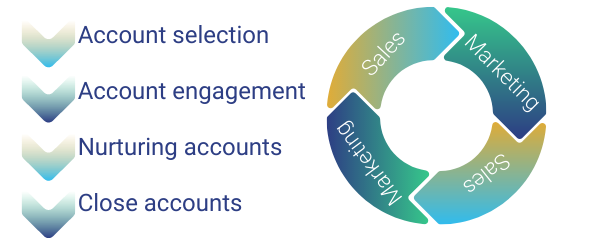Account-based marketing (ABM) is taking B2B by storm. The latest trend in sales and marketing, ABM is a highly effective way to engage with potential leads. Our clients are doing it, and the ones who aren’t yet are interested. But what is ABM meaning? Here’s an in-depth walkthrough of the account-based marketing framework for beginners.
ABM Meaning: What is Account-Based Marketing?
First thing first, let’s define account-based marketing. According to HubSpot, “Account-based Marketing (ABM) is a focused growth strategy in which Marketing and Sales collaborate to create personalized buying experiences for a mutually-identified set of high-value accounts.”
Now, let’s break that down piece by piece to define what that actually means.
A Focused Growth Strategy
There are many ways and tactics to implement account-based marketing; however, it’s important to note that the framework of account-based marketing is strategy, first and foremost. Marketo states that it’s a “customer experience-centric approach” in order to “generate more revenue faster and easier.”
At its core, ABM is about understanding that not every company fits your product/service. While a buyer’s persona is a fictional representation of your ideal buyer, ABM takes the next step to find, target, and talk to those ideal accounts. ABM is the strategy behind that process and implementation.
Marketing and Sales Collaboration
This part is critical. Account-based marketing is the pinnacle of sales and marketing alignment. The ideal process of AMB is: to identify accounts, communicate with accounts directly, and nurture and close deals on those accounts. Sales, Marketing, Sales. All in close collaboration.
Therefore, once you have your ideal types of accounts in mind, the next step in ABM is for your sales team to identify specific ones. Sales should create a prospect list of companies or people your company should speak with. (This is the account part of account-based marketing.) Once this list is created, it should be handed off to Marketing.
Marketing will then implement your targeting strategy. There are more specific tactics below, but Marketing’s role may include LinkedIn advertising or connecting and engaging on social media. Marketing is responsible for carrying the strategy forward, making the connections, and starting the conversations.
When the conversations are activated, and a prospect becomes an active lead, it’s handed back to Sales to nurture and close.

Without sales and marketing alignment, the entire account-based marketing process would fall on its face. Marketing needs to know who specifically to talk to. Is targeting anybody under the executive level a waste of time? Were conversations with X company already conducted and lost?
And Sales needs Marketing to implement the tactics. A breakdown on the latter half of this may mean Marketing is hooking leads that Sales isn’t receiving or following up on.
Discover how the ABM meaning connects to personalized buying experiences.
Personalized Buying Experiences
Another important arm of the account-based marketing framework is the element of personalization. Because the accounts chosen in ABM are already highly targeted, messaging needs to target, too.
However you connect with your prospects needs to be authentic, helpful, and personalized. That means doing your research beforehand. Leave anything generic at the door. Also, take timeliness and relevance into high consideration. Personalization might look like custom landing pages, custom calendar links to schedule a consult directly, or references specific to the account you’re connecting with. Whatever your channel, there are many account-based marketing tools to drive scale and efficiency.

Mutually-Identified High-Value Accounts
As granular and targeted as inbound marketing can be, ABM is next-level targeting. As such, it’s more time-intensive. That translates into being selective about accounts that are not only the best fit but also stand to be the most lucrative.
A study by SiriusDecisions found that “91% of companies using ABM were able to increase their average deal size, with 25% of respondents stating the increase being over 50% or larger.”
The specific nature of ABM allows teams to key in on those high-value accounts and put more effort into nurturing them. The alignment between teams empowers Marketing to develop the specific collateral and assets to enable Sales in their nurturing. Under the ABM model, it’s easier to make a case for investing time and resources into this process when accounts and the rewards are high-value.
Thinking about implementing ABM? Take the assessment to see if it’s right for your organization.

Account-Based Marketing Examples
Now that we’ve defined ABM meaning and its framework, here are some ways to implement it.
- Launch a LinkedIn In-mail campaign
- Conduct account-based retargeting and advertising
- Host targeted events and reach out to invite accounts directly
- Direct mail small gifts and follow up via email
- Create custom landing pages
- Record and email a personalized video
Key Takeaways on Account-Based Marketing Framework:
- Account-based marketing is firstly a strategy – not just a tactic
- ABM requires high alignment and collaboration between Sales and Marketing teams
- Personalized experiences and messaging are necessary under the ABM model
- AMB targets specific, high-value accounts that both Sales and Marketing agree to engage
Discover Deeper ABM Meaning With Lake One
There is undoubtedly more to the ABM meaning than just its definition. Lake One can help you make the most of your account-based marketing strategy with sales and marketing alignment to drive revenue fast.
Get started and contact us today.


